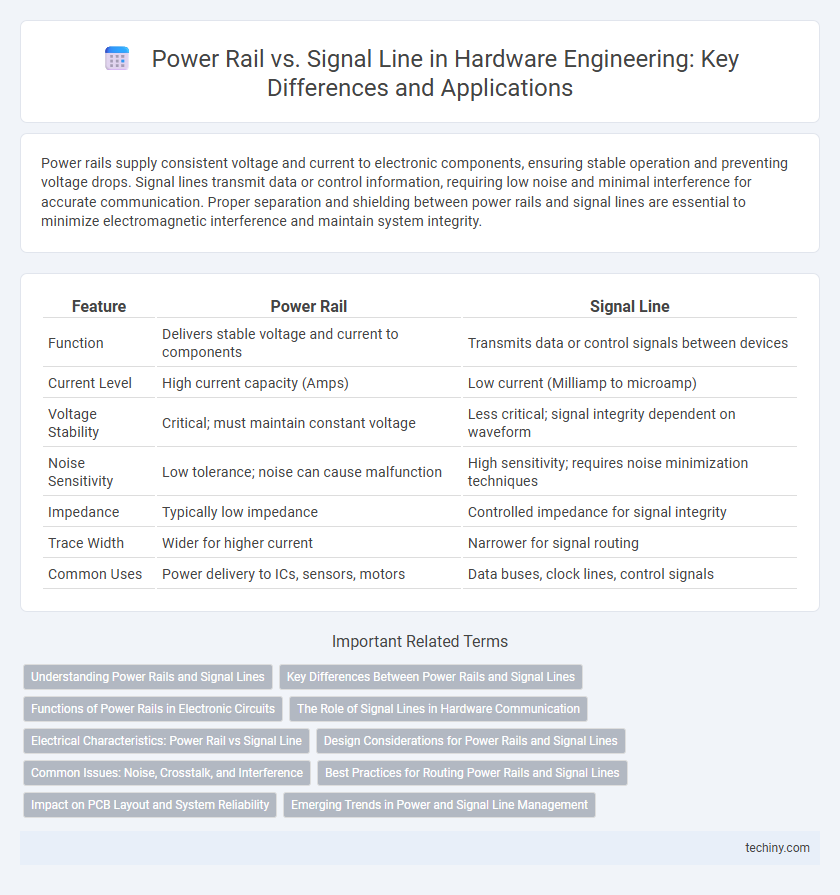Power rails supply consistent voltage and current to electronic components, ensuring stable operation and preventing voltage drops. Signal lines transmit data or control information, requiring low noise and minimal interference for accurate communication. Proper separation and shielding between power rails and signal lines are essential to minimize electromagnetic interference and maintain system integrity.
Table of Comparison
| Feature | Power Rail | Signal Line |
|---|---|---|
| Function | Delivers stable voltage and current to components | Transmits data or control signals between devices |
| Current Level | High current capacity (Amps) | Low current (Milliamp to microamp) |
| Voltage Stability | Critical; must maintain constant voltage | Less critical; signal integrity dependent on waveform |
| Noise Sensitivity | Low tolerance; noise can cause malfunction | High sensitivity; requires noise minimization techniques |
| Impedance | Typically low impedance | Controlled impedance for signal integrity |
| Trace Width | Wider for higher current | Narrower for signal routing |
| Common Uses | Power delivery to ICs, sensors, motors | Data buses, clock lines, control signals |
Understanding Power Rails and Signal Lines
Power rails provide stable voltage levels necessary for circuit operation and are designed to handle high current loads with minimal voltage drop. Signal lines transmit data or control information and require impedance matching and shielding to prevent noise and crosstalk interference. Effective hardware engineering relies on differentiating power rails for reliable power distribution and signal lines for precise communication within electronic systems.
Key Differences Between Power Rails and Signal Lines
Power rails deliver stable voltage and current required for device operation, while signal lines transmit data or control information through varying electrical signals. Power rails typically have lower impedance and higher current capacity to maintain consistent power distribution, whereas signal lines prioritize signal integrity and noise reduction for accurate data transmission. The design considerations for power rails focus on minimizing voltage drop and electromagnetic interference, while signal lines emphasize impedance matching and shielding to preserve signal clarity.
Functions of Power Rails in Electronic Circuits
Power rails provide a stable voltage supply essential for the operation of electronic components, ensuring consistent power delivery and preventing fluctuations that could cause malfunction or damage. They distribute current efficiently across the circuit board to maintain performance integrity and support the activation of integrated circuits and sensors. Power rails also play a crucial role in noise reduction and signal integrity by minimizing voltage drops and electromagnetic interference within complex hardware systems.
The Role of Signal Lines in Hardware Communication
Signal lines in hardware communication serve as critical pathways for transmitting data and control signals between components, ensuring precise synchronization and operational efficiency. Unlike power rails that supply stable voltage levels essential for device functionality, signal lines carry varying voltage levels representing binary information. The integrity and timing of signal lines directly impact system performance, making their design and shielding vital in minimizing noise and electromagnetic interference.
Electrical Characteristics: Power Rail vs Signal Line
Power rails maintain a stable voltage supply with low impedance to ensure consistent current delivery and minimize voltage drops, critical for reliable hardware operation. Signal lines prioritize high impedance and controlled impedance matching to preserve signal integrity and reduce noise susceptibility during data transmission. Electrical characteristics of power rails emphasize current capacity and voltage stability, whereas signal lines focus on minimizing cross-talk and maintaining signal timing fidelity.
Design Considerations for Power Rails and Signal Lines
Power rail design prioritizes stable voltage delivery, low impedance paths, and minimal voltage drop, requiring wide traces and careful placement of decoupling capacitors to handle high current demands and reduce noise. Signal line design emphasizes controlled impedance, signal integrity, and crosstalk reduction, often utilizing differential pairs, proper trace spacing, and termination techniques to preserve timing and data fidelity. Both power rails and signal lines must consider PCB layer stack-up, material properties, and electromagnetic interference to ensure reliable hardware performance.
Common Issues: Noise, Crosstalk, and Interference
Power rail noise often originates from rapid switching currents causing voltage fluctuations that degrade circuit performance. Signal lines are highly susceptible to crosstalk, where electromagnetic coupling between adjacent traces induces unwanted interference, leading to data corruption. Effective hardware engineering employs proper grounding, shielding, and careful PCB layout techniques to mitigate noise, crosstalk, and electromagnetic interference in both power rails and signal lines.
Best Practices for Routing Power Rails and Signal Lines
Power rails require wider traces to handle higher current loads and minimize voltage drop, with careful attention to maintaining low impedance and avoiding sharp bends. Signal lines benefit from controlled impedance routing and consistent trace width, with adequate spacing to reduce crosstalk and electromagnetic interference. Implementing separate layers for power and signals and using ground planes strategically enhances signal integrity and overall PCB performance.
Impact on PCB Layout and System Reliability
Power rails require wider traces and thicker copper to handle higher current loads, impacting PCB layout by increasing board area and complexity. Signal lines demand careful impedance control and routing to minimize noise and crosstalk, critical for maintaining signal integrity and system reliability. Proper separation and shielding between power rails and signal lines reduce electromagnetic interference (EMI), enhancing overall device performance and longevity.
Emerging Trends in Power and Signal Line Management
Emerging trends in power rail and signal line management emphasize advanced integrated circuit techniques that enhance power distribution and signal integrity. Innovations in low impedance power rails combined with adaptive signal line routing reduce electromagnetic interference and improve overall system performance. The adoption of AI-driven design tools accelerates optimization of power delivery networks and high-speed signal paths in complex hardware engineering projects.
Power Rail vs Signal Line Infographic

 techiny.com
techiny.com